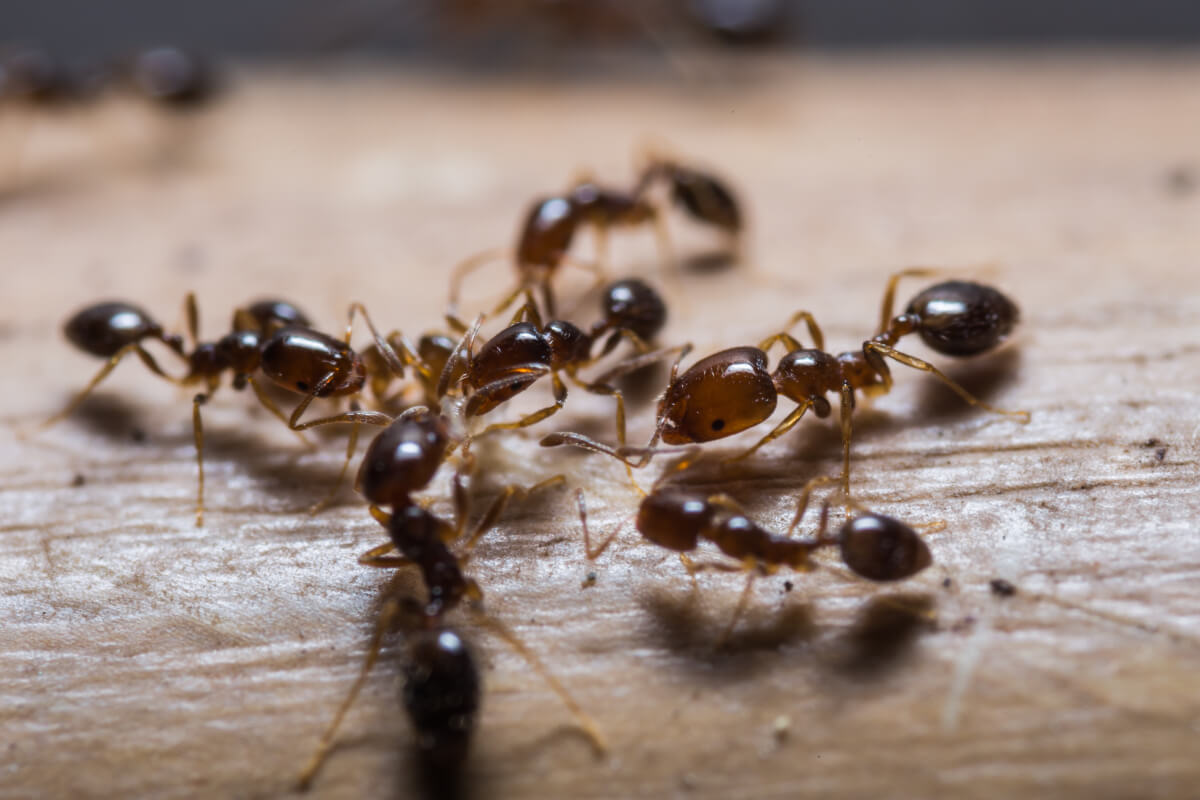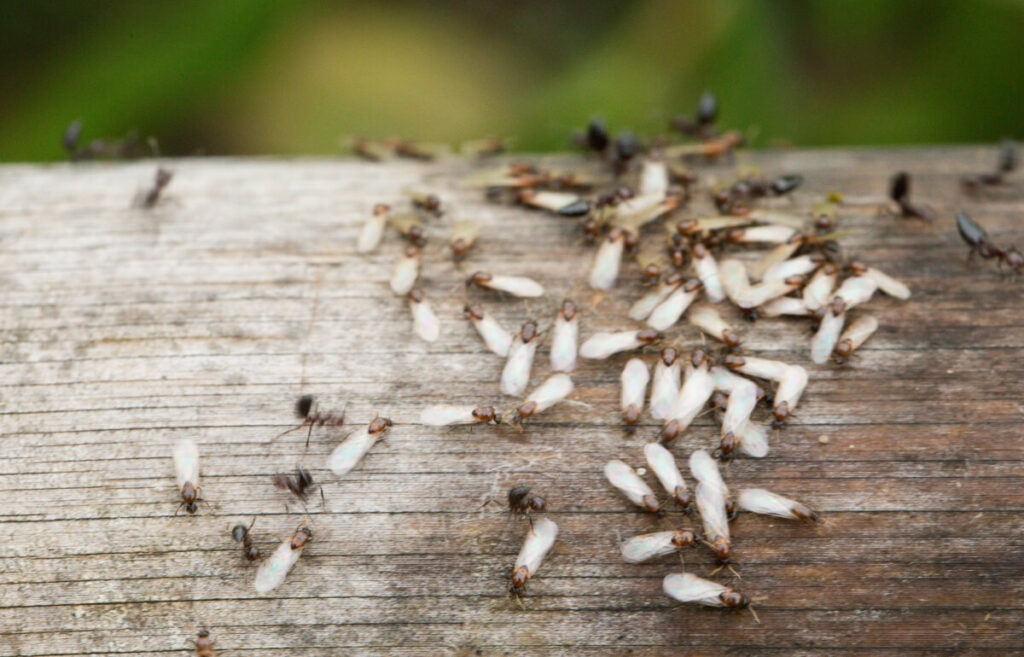
Some homeowners rest easy knowing that their home is safe from ant infestations because they don't see a single ant or ant trail crawling around their kitchen. However, they’re left with mysterious signs of what seems to be winged termites, such as piles of sawdust and rustling noises from crevices. While those may be termites, there’s a good chance that those could also be carpenter ants - they also nest in wood and are mostly present during nighttime, which is why they aren’t caught that easily.
So why can't you see carpenter ants during the day? The main reason why you don't see carpenter ants during the day is that they prefer to forage in search of food in times of the day when there’s little traces of human activity that might threaten their peace, or their lives. However, you may also see some carpenter ants come out during the daytime looking for food especially during spring and summer. If you suspect a carpenter ant infestation in your space, you should look during the evening or dawn.
Carpenter ants are one of the nocturnal types of ants, which means they come out to forage at night. Because of this, you may not see them during the day. However, you might see some of them during the daytime, but that usually happens during spring and summer. Carpenter ant activity boils down to their seasonal behavior on foraging and diet. These will be important to learn about for you to come up with an effective ant control strategy.
Some ants can be seen during the day, while some are nocturnal. The first step for getting rid of ants in your home is to identify and ensure what kind of species they are.
Carpenter ants fall into the category of nocturnal ants. They have reddish-black bodies with only one node at their waist and an evenly rounded thorax. Female worker ants are 3/8 inch up to 1/2 inch for larger workers, while some species are smaller at 3/8 inch. A carpenter ant colony only has a single queen as big as an inch.
While these ants mostly forage at night, you may still see them during the daytime when it's spring or summer, looking for a food source. Since they’re cold-blooded, they are usually dormant during winter, except when their nests receive adequate heat and moisture. Because of this, carpenter ants are difficult to locate as they stay mostly in their satellite nests or parent nest.
A carpenter ant nest is usually located in moist wood, such as tree limbs, tree stumps, dead trees, and other decayed wood, which is around 100 yards from their food source. They also create satellite nests in your home by digging galleries in wood.
Because of this, they're sometimes mistaken for termites, but they don't eat wood like termites - they only create indoor nests. However, they shouldn't be taken lightly because they can cause grave structural damage in your home.
Since nocturnal carpenter ants may be difficult to spot, their foraging and diet may give you an idea if they're around or if you're really up against carpenter ants. For one, they only forage at night, though they may come out even during the daytime in summer or spring.
Carpenter ants prefer food rich in protein and carbohydrates. When outdoors, their diet usually consists of dead insects, honeydew, sweet juicy fruits, and other sweet foods. Ants foraging indoors eye on protein-rich food, such as meat, fish, and greasy or fatty food, including pet food. They’ll also feast on sugary food in your home.
Ant paths outdoors may be caught along tree branches, while indoor ant trails might be cabinets, countertops, window sills, and more.

For you to be able to wipe out an entire colony of carpenter ants, you must also look for other signs of their presence other than knowing their diet and foraging behavior through the seasons. Some of the common signs of carpenter ant infestation are sightings of coarse sawdust, frass, damaged wood, winged ants, subtle noises from the wall void, and the presence of worker ants.
Seeing piles of wood shavings in the corners of your home is an obvious warning sign that carpenter ants might be building satellite nests. These destructive pests burrow into wooden structures, even sound wood, to create galleries for nesting.
Carpenter ants create frass: a mixture of feces, insect parts, and sawdust. If you find one of these in dark areas of your house with a high moisture meter, such as your crawl space under your house, patio, or porch, you might be having a carpenter ant infestation. You may see this on the floor or stuck to a wall or in crevices.
Damaged wood is one of the telltale signs of carpenter ant infestation. These ants are attracted to damp wood because it satisfies their needs for a warm and humid nest. Inspect wooden fixtures in your house if there's any damage. Some of the common areas are the wooden panels under your stairs and deck. You might also want to check your cabinets under the sink. If you find any changes, it might be carpenter ants, termites, or rats.
Reddish-black winged ants may also be a sign of carpenter ants in your house. Winged ants are a type of ants in a colony tasked to produce a satellite colony or another active colony. Winged carpenter ants are lured in by light, so you may catch them in your sliding glass doors or interior windows as they find ways to enter. They become successful most of the time, mate in 30 minutes, and disperse.
Seeing a black carpenter ant is enough to clue that there’s an ant infestation–it’s just a matter of how bad they have infested your house. You may also hear them as they work on damaging your wood and chewing on its support beams. Call reliable pest management professionals in your area immediately to inspect pest infestation.
You may still try several ways for getting rid of carpenter ants in your home. If done right, these may be enough in serving as your first line of defense. Some options to consider are installing ant baits, treating your perimeter with a non-repellent spray, and trying home remedies.
Ant baits are one of the effective methods for eradicating ants in your home. They also come in different types suitable for the kind of infestation you have. You can choose between solid bait, liquid bait, and granules. Experts have also designed bait products to be appealing to ants with their sugary or protein-y formulation.
When choosing an ant bait, opt for the one with a slow-acting effect. The worker ants need enough time to nibble on it, deliver it to their nest, and distribute the food to other ants, including the queen. By the time the poison kicks in, it can already affect the entire colony, if not most of the ants.
Avoid using any other insect repellent sprays when dealing with ants because that will make them spread and exacerbate your ant infestation. Choose non-repellent sprays instead and treat the perimeter of your home.
Ants that have crawled on treated surfaces will also bring the solution to their colony. The chemical will spread in their nest and eradicate most, if not all ants.
Some carpenter ant repellent products may actually be seen in your kitchen or gardening shed. Most of them are ideal only as deterrents and couldn’t really remove the infestation. Ants follow their trail with the pheromones other ants leave, so these deterrents work by erasing those chemical signals. Here are some of the home remedies you can try out:
While these home remedies can be reliable for preventing further ant infestation, they wouldn’t be enough for removing ants.

Carpenter ant damage costs millions of dollars in a year in the United States. With their nocturnal behavior, it may be difficult to spot them, and by the time you do, the infestation might already be worse. Contact a reliable pest control professional, such as Yale Pest Control.
We’re a pest control company with 40 years of experience. We’re well-equipped with knowledge about the behavior of common household pests and the best solutions for eradicating them. Contact us for a free quote today.